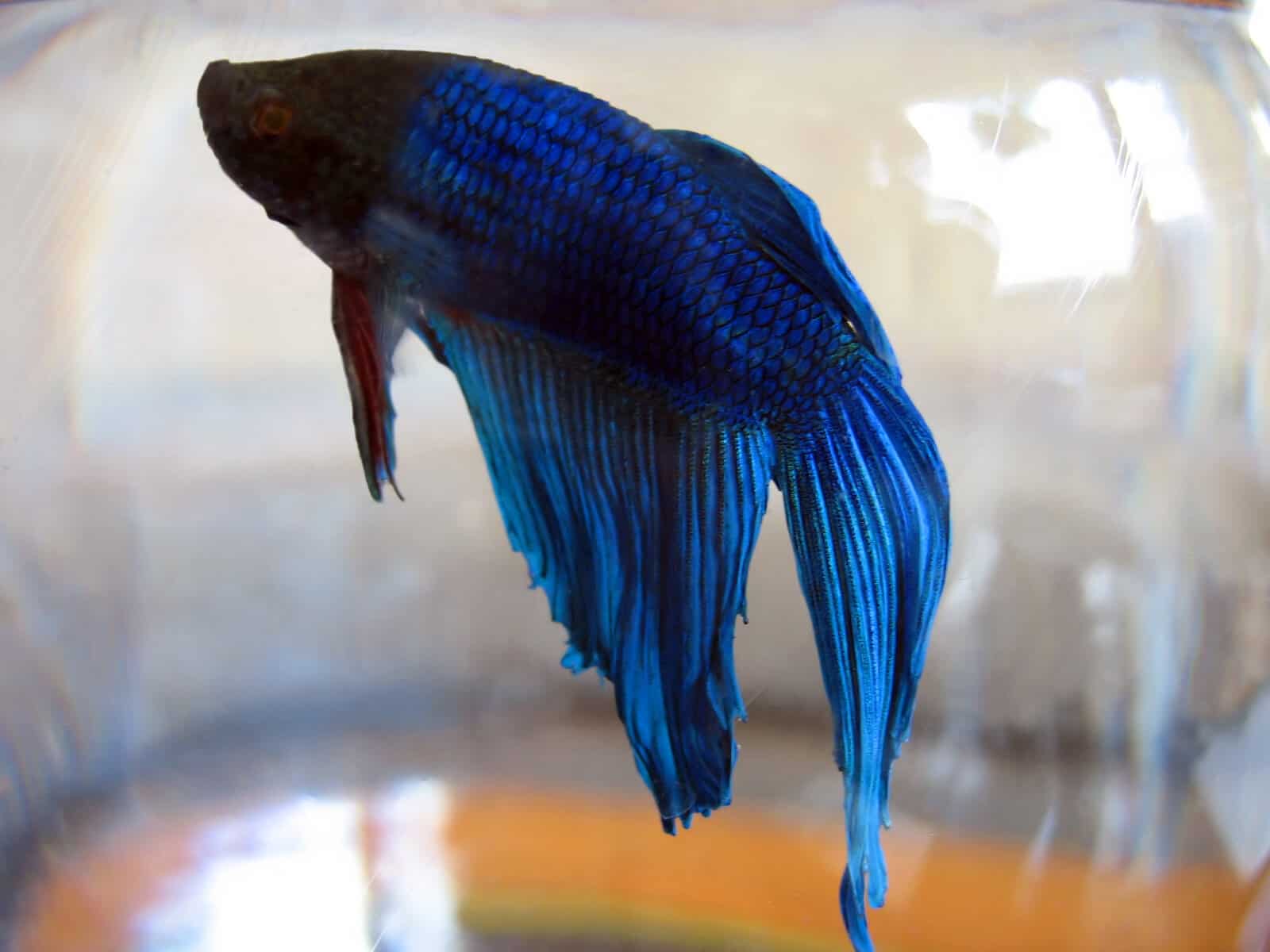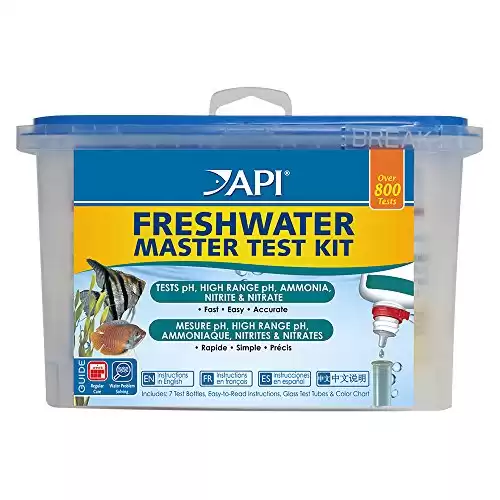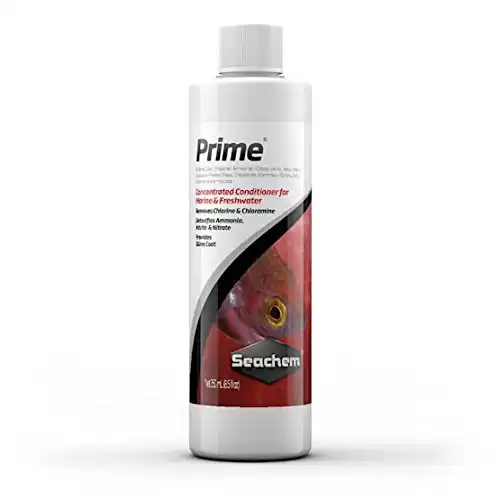One of the reasons we all love betta fish so much is their stunning, long flowing fins that they use to show us and one another how they’re feeling.
Whereas erect, puffed-out fins indicate a betta in prime health, fins that are constantly clamped or closed can be a sign of an underlying health problem or disease.
If your pet betta fish has clamped fins, it’s important to find out what the root cause of the problem is so you can treat it effectively. Here we’ll take a look at some of the most common reasons for clamped fins and how you can remedy them.
Why Does My Betta Have Clamped Fins?
Here is a list of the most common causes of clamped fins in betta splendens, the Siamese Fighting Fish:
Poor Water Quality
The number one root cause of clamped fins in betta fish is poor water quality. Poor water conditions can lead to myriad other problems in betta fish, all of which could lead to your betta clamping its fins.
When betta fish are constantly overfed or kept in water that’s not being regularly cleaned, oxygen levels get depleted, ammonia, nitrite, nitrate, and phosphate levels can spike, and bacterial and parasitic diseases may take hold.
All of these things can quickly make your pet fish get sick and clamp its fins, which is why ensuring good, clean water is a top priority both in the prevention and treatment of clamped fins in betta fish.
Fish Tank Too Small
Despite some of the myths that insist you can keep betta fish in jars or tiny fish bowls, bettas really need a minimum of a 5-gallon tank with a filter to remain happy and healthy.
Having said that, even 5-gallon tanks are notorious for being difficult to manage because the water conditions in such a small body of water can change incredibly quickly!
A 10-gallon or 15-gallon tank provides additional gallons of water to buffer sudden changes and also offers your betta more space to enjoy exploring.
Bettas in small, cramped tanks are prone to all kinds of health problems, and a depressed betta may clamp its fins while becoming less interested in food or other stimulation.
Low Water Temperature
Another common cause of clamped fins in betta fish is water temperatures that are too low. Betta fish come from warm, tropical regions of southeast Asia and prefer water temperatures in the range of 78-81 Fahrenheit.
Since they are cold-blooded animals, bettas need sufficient warmth in their environment to remain healthy.
If temperatures fall below their ideal range, your betta could become stressed, clamp its fins, and hang around at the surface of the tank or near the heater where the temperature will be warmer.
Cold temperature stress can be especially serious if the change happens suddenly – such as during a large partial water change or a power outage.
High Temperature
Although a less common problem than low water temperatures, high water temperatures have the potential to make your betta fish feel unwell too.
If there’s a problem with your thermostat or you have set the temperature dial incorrectly, your water could overheat, causing your oxygen level to become depleted and your betta’s metabolism to speed up.
The combination of these two factors could eventually leave your fish feeling exhausted, clamping its fins and remaining fairly motionless at the top of the tank.
Incorrect Water Parameters
Betta fish prefer a water pH that’s neutral or slightly acidic, with a range between 6.5 – 7 and a hardness of between 5-20 dGH.
If your water becomes too soft and acidic your fish’s metabolism will slow down, causing them to eat less and become less active. In some circumstances, skin lesions or burns may also appear on their skin.
If your water becomes too hard and alkaline your betta’s skin will become irritated and you’ll likely see them itching themselves on the aquarium rocks and gravel.
Both of these conditions can become quite serious, and a betta that is unhappy with its water chemistry may show distress by clamping its fins and becoming less active.
Shock
Following on from temperature and pH stress, a betta fish may become shocked if their temperature, water chemistry, or environment changes very suddenly.
This is common when a betta fish is introduced to a new tank. Since the conditions of your tank won’t perfectly match those of the tank that the betta was moved from, your fish will always need to adapt to the conditions of the new environment.
But, if the gap between the tank conditions is too great, or if you introduced your betta to your tank without acclimatizing him first, the sudden change can cause shock, making your betta feel very vulnerable and clamping its fins.
Shock can also be caused by rough handling or severe bullying from incompatible tank mates, so it’s always important to be as gentle as possible when moving a betta fish and to choose tank mates with great care.
Bullying and Incompatible Tank Mates
Betta fish are also known as Siamese Fighting Fish because of their notorious tendency to fight with one another. If you keep more than one male in the same tank, they’re likely to fight, resulting in stress, severe injuries, and even death.
But betta fish are not just aggressive – they can also be quite vulnerable to attack. Because of their long fins, bettas make easy targets for fish that like to nip fins, such as barbs, gobies, and serpae tetra.
A betta fish that’s feeling intimidated and vulnerable to attack may well clamp its fins, and an individual that’s been seriously injured by fighting will often do the same.
Disease
Bettas suffering from serious diseases and health issues will often clamp their fins as a sign of distress. Ich and Velvet diseases are quite common in betta fish, resulting in either white spots or a golden film developing on the skin.
Other ailments that could result in fin clamping include severe fin rot, dropsy, flukes, and swim bladder disorder, as well as internal viral and bacterial infections such as septicemia.
Old Age
Clamped fins are a broad sign of ailing health, and one reason for this could be old age. Although they have been known to reach 10 years in age, pet betta fish often live less than 3 years, and if yours is above this, health problems can be more common.
If your betta is more than 3 years old and suddenly clamps its fins and becomes less interested in food, he may not be planning to stick around much longer.
That’s not to say its condition is always untreatable though, and we’d still highly recommend carefully looking through our list here to see if there are contributing factors that could be treated.
Genetic Disorder
Sadly, some bettas may occasionally be born with a genetic mutation that produces permanently clamped fins. It should be obvious if this is the case since your fish will have had clamped fins from the very beginning.
When buying a betta fish at the pet store, always make sure you choose one with healthy-looking, intact fins that the fish can erect properly.
If you’re buying online, only buy from experienced, reputable sellers to ensure that you receive a healthy fish without any genetic abnormalities.
How To Treat Clamped Fins in Betta Fish

Thankfully, most of the above causes of clamped fins can be treated. Let’s take a look at some of the best treatments for the various causes of clamped fins in betta fish here.
Improve Your Water Quality
Test your tank’s water with an API test kit for ammonia, nitrite, and nitrate. If any of these are too high, your fish’s life could be in immediate danger, and you should perform an emergency 50% water change with water of matching temperature to avoid disaster.
- Accurately monitors 5 most vital water parameters levels in freshwater aquariums: pH, high range pH, ammonia, nitrite, nitrate
- Designed for use in freshwater aquariums only
- Use for weekly monitoring and when water or fish problems appear
In the long run, water quality can be vastly improved and maintained with a proper feeding regime, an efficient filter, and a regular cleaning schedule.
If you have a 10-gallon tank, even a simple sponge filter with a reliable air pump could do a good job at mechanical and biological filtration. For larger tanks, you could consider a hang-on-back (HOB) filter that provides additional chemical filtration with carbon too.
Perform gravel cleaning and 15% partial water changes every week, or 30% every two weeks with treated, chlorine-free tap water to maintain low nitrate and phosphate levels, less algae, and a healthy tank ecology.
- POWERFUL TREATMENT: Seachem Prime is a complete and concentrated conditioner for both freshwater and saltwater fish tanks, working hard to remove chlorine and chloramine.
- USE: Use 1 capful (5 mL) of Seachem Prime for each 200 L (50 US gallons) of new or replacement water.
- SAFETY: In case of an emergency, the 5x dose of Seachem Prime may be used for both ammonia and nitrite.
Adjust Your Water Temperature
To understand whether clamped fins are caused by your water temperature, you need a reliable thermometer, positioned away from the heater to test the overall temperature of the tank’s water.
If the temperature range falls outside of the 78-81 Fahrenheit bracket, adjust the dial on the heater’s thermostat to correct it, and check the thermometer again in one hour.
Make minor adjustments until the water temperature remains constantly within the desired range.
Correct Your Water Parameters
Regular water testing is a routine part of good aquarium management. Test your water once a month to make sure that your water pH and hardness are at the correct levels.
- Accurately monitors 5 most vital water parameters levels in freshwater aquariums: pH, high range pH, ammonia, nitrite, nitrate
- Designed for use in freshwater aquariums only
- Use for weekly monitoring and when water or fish problems appear
If your tank’s water is much outside of the ideal pH 6.5-7 range, you’ll need to adjust it to make your betta happy again.
If your tap water is alkaline by nature, you could try softening it by adding natural ornaments that contain tannins. Indian almond leaves and hardwood driftwood are good at gradually releasing tannins into the water, which lowers the pH of the water.
Rocks and substrates containing limestone or coral should be removed in a tank that has high pH since they tend to bring the water pH up, but if your water pH is too low, you could use these, as well as small quantities of baking soda to bring your water’s pH up.
Remove Troublesome Tankmates
If you’ve identified that your betta’s fins are clamped due to being stressed or bullied by incompatible tank mates, it’s time to remove the aggressive fish causing the problem and replace them with peaceful fish, or alternatively, offer your betta its own independent tank.
Peaceful, robust tank mates for bettas include corydoras catfish, white cloud mountain minnows, nerite snails, and Amano shrimp and ghost shrimp.
Treat Diseases and Infections
If your betta’s clamped fins are caused by an infection, it’ll need treatment as soon as possible for the best possible outcome.
Parasitic infections like ich can be treated at home by placing your betta in its own hospital tank and gradually raising the water temperature and applying liquid medications.
Bacterial infections are best treated with antibiotics, although these are not always available without first consulting a vet.
Swim Bladder disorders, constipation, or dropsy are often treated with an Epsom salt bath or by feeding with blanched peas to clear the gut.
Each of these diseases needs careful understanding, so we’d highly recommend checking out the diseases section on our website or consulting a specialist fish vet for the most effective diagnosis and treatment.
Clamped Fin Betta FAQs
Why Does My Baby Betta Have Clamped Fins?
If you’ve bred a fresh brood of baby betta fish and some of them have clamped fins, they may be showing signs of a congenital disorder that might affect them for the rest of their lives.
If all of your baby bettas have clamped fins, however, it’s time to act fast because it’s probably a sign that there’s a significant issue with your tank’s temperature, water parameters, or water quality.
Breeding tanks are renowned for water quality issues and need cleaning much more regularly than ordinary fish tanks.
Why Is My Betta Losing Color With Clamped Fins?
Like clamped fins, the loss of color is another classic symptom of poor overall health in betta fish.
Loss of color often goes together with clamped fins when a bettas environment isn’t at optimal conditions, when they feel stressed or shocked, or when they have an infection.
Why Does My Female Betta Sorority Have Clamped Fins?
If a whole group of female bettas has clamped fins it’s a clear sign that there’s a problem with your tank’s water conditions, temperature, or stocking density.
If just one or two of your girls have clamped fins, though, it may be connected with the stress they’re feeling from being intimidated by more dominant females.
Remember that female betta fish are still semi-aggressive and can bully and injure one another too.
As always with betta fish, provide plenty of plants and hiding places to give them a place of refuge to feel more comfortable, secure, and happy in the tank, and make sure the tank is large enough for each of them to establish their own personal territories.
Conclusion
Clamped fins are a classic sign of an underlying problem either in the entire aquarium or with an individual betta fish.
Using our list above, we hope it’s easier for you to diagnose the problem your betta is facing and take the right action to treat it.
Most of the problems associated with clamped fins are perfectly treatable, so with the right remedy, your betta could well be back to its brilliant best in no time.




